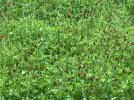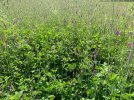How many people mix in an annual clover with their brassicas for nitrogen? If I remember correctly, I think Paul was opposed to it because the brassicas would shade them out. I never have planted them together in the past , but was thinking of adding Crimson Clover this year. If the brassicas are going to shade out the clover, how is the clover working? How many people mix or do you just use Urea at planting then 4 weeks later. Thanks
You are using an out of date browser. It may not display this or other websites correctly.
You should upgrade or use an alternative browser.
You should upgrade or use an alternative browser.
Annual clover with brassicas?
- Thread starter BobinCt
- Start date
S.T.Fanatic
5 year old buck +
There isn't enough time for the clover to produce the N needed when planted together. A better method would be to plant a bi annual clover like medium red in the fall and plant your brassica into it next summer.
BenAllgood
5 year old buck +
I did a mix of crimson clover, turnips, and radishes in zone 6b this past fall. The deer devoured the radishes early, left the turnips alone until late season, but munched on the crimson clover from September through this past spring. I think my clover did well because the brassicas weren't too thick. I did frost seed some red clover before spring greenup, but will add it during the fall this year.
But, like @S.T.Fanatic said, the crimson isn't going to give your brassicas nitrogen yet. It exudes nitrogen when the roots start decaying.
But, like @S.T.Fanatic said, the crimson isn't going to give your brassicas nitrogen yet. It exudes nitrogen when the roots start decaying.
j-bird
Moderator
I like adding an annual clover simply for diversity. I like as much green out there as I can get. My deer are picky and don't like turnips (greens or the bulbs) for the most part until it's all that is left and then then just pick at them like a stubborn toddler at the table with a plate of broccoli! I also like adding a cereal grain as well...I like trying to have something stay green as long as possible and then green up as soon as possible as well.
Bassattackr
5 year old buck +
Paul (any many others) plant brassicas after tilling down spring planted (or the previous fall) annual clovers. Crimson is a great "green manure" for this purpose. The majority of the N is released when the clover is tilled under before planting, allowing you to save on N fertilizer. Otherwise, most is lost to the atmosphere.
You're right about them getting shaded out most times, depending on your planting density, some may still survive..
You're right about them getting shaded out most times, depending on your planting density, some may still survive..
yoderjac
5 year old buck +
How many people mix in an annual clover with their brassicas for nitrogen? If I remember correctly, I think Paul was opposed to it because the brassicas would shade them out. I never have planted them together in the past , but was thinking of adding Crimson Clover this year. If the brassicas are going to shade out the clover, how is the clover working? How many people mix or do you just use Urea at planting then 4 weeks later. Thanks
I mix a little brassica with my annual clover and cereal. Paul is right, if you use seeding rates over about 2 lbs/ac brassica can shade out other things in the mix. I have never intentionally added commercial N to my plots and I have not used any fertilizer for about 5 years now. My rotation/mixes for my feeding plots are:
For Summer: Sunn Hemp and Buckwheat. Sunn Hemp is a legume that can fix a lot of N into the soil.
For Fall: Winter Rye @ 80-100 lbs/ac, Crimson Clover at about 10 lbs/ac, and PTT at about 2 lbs/ac.
I get plenty off good size turnip bulbs if I plant early. Keep in mind that most of the N is released when legumes die. This means that most of the N from the clover is released after that year's brassica crop is done, but it will become available for the next crop. That is one reason to plant for summer, even in the north, to bank N for the fall plant.
Thanks,
Jack
yoderjac
5 year old buck +
I planted a perennial clover with my brassica mix last week in hopes of it coming up strong in the spring and providing N for next falls brassica planting.
I plant via spray/thrown/roll
Anyone do this?
Most perennial clovers take a long time to establish. I use an annual clover, Crimson Clover, that acts as a reseeding annual in my area. It may not act that way further north. I'd consider Medium Red clover which is a short-lived perennial that is faster than many long-lived perennials if you are going to terminate and replant in the fall.
Most perennial clovers take a long time to establish. I use an annual clover, Crimson Clover, that acts as a reseeding annual in my area. It may not act that way further north. I'd consider Medium Red clover which is a short-lived perennial that is faster than many long-lived perennials if you are going to terminate and replant in the fall.
I will try med red next year. I wanted to use something slow to establish so it didn't compete with the brassica. I was thinking of top dressing the brassica after its established with WR to help as cover crop for clover in spring. Think that would work?
yoderjac
5 year old buck +
I will try med red next year. I wanted to use something slow to establish so it didn't compete with the brassica. I was thinking of top dressing the brassica after its established with WR to help as cover crop for clover in spring. Think that would work?
In general, it depends on your seeding rates and conditions. When brassica rates are high, once the get started, they shade out everything else. The also eat a lot of N. If your browse pressure is heavy and the brassica is sparse and you still have time for WR and clover to germinate you might have some luck. In general, I much prefer mixing and keeping brassica rates low. You reduce disease risk and the plants complement each other. They use and replenish different resources into the soil. Each plant peaks at a different time and is more attractive to deer during that peak. This keeps the field attractive over a longer period.
Keep in mind that I find "yield" to be mostly irrelevant to managing deer. There are two major reasons to plant food plots: 1) For QDM purposes to improve herd health, and 2) for attraction to improve hunting.
First, 1) does not come into play unless quality food is a limiting factor for the local deer herd, and you have sufficient scale (acreage and resources to manage it). If this is an objective, we need to keep in mind that regardless of what we plant, it is a small fraction of a deer's diet. Most of their diet will consist of native foods. So, food plots become "supplemental". They need to be targeted to produce quality food during stress periods when quality native foods are scarce. This evens out the dips in quality native foods. The stress periods that you target will depend on your location. If something you plant does not end up in the belly of a deer, it is not contributing to your goal. And since you need sufficient scale to impact the herd (converting 1%-3% of a deer's home range from poor to high quality food during stress periods. So, if you are planting 1% to 3% of a deer's home range and there is food left in the field after the stress period is over, you have met your goal. It is much more important to focus on soil health and nutrient cycling rather than maximizing yield.
Number 2) comes into play for most folks because of the lack of scale to have a measurable impact on herd health. Once again, I find yield to be over rated. If you plant a monoculture and fertilize the crap out of it, you can increase yield, but does this improve hunting? I could contend that planting a sound mix of crops that peak at different times keeps the field attractive over a longer time period. In general, if your crops are being wiped out by deer, you either you are planting too little acreage for your deer numbers or you are planting crops that are too attractive. In this kind of case, one would either need to increase acreage being planted or shoot more does to get the population in balance with the land.
Thanks,
Jack
yoderjac
5 year old buck +
Yep, I think that's a better choice for places further north than me. I use it a lot for "resting" fields. In a previous post, I talked about my summer/fall rotation. I pick one field that hasn't been "rested" for a while. I replace the CC in my fall plant with Medium Red. I'll then maintain that field in the medium red for 2-3 years before bringing it back into rotation. "Resting" in this context means no herbicides and I'm only on the field once or twice a year with a tractor for mowing. This helps break the cycle of repeated broad spectrum herbicide use and allow a natural balance of weeds to return. There are some weeds that are naturally resistant to each herbicide. By using it, we favor those weeds that are resistant. Many weed can be great quality deer food and with a natural balance of weeds, you get plenty of good deer food. That is why techniques like slight soil disturbance and controlled burns produce lots of deer food.Crimson won’t overwinter up here in the upper Midwest. I just use medium red. It’s cheap if it doesn’t work.
While herbicides have their place and they allow us to avoid deep tillage that disturbs soil tilth and burns OM at a high rate, they also have downsides. I've learn that there is a balance to pretty much everything.
Thanks,
Jack
Bassattackr
5 year old buck +
If it were me, I would not bother adding clovers to the brassica plot. There is no measureable advantage in nitrogen gain in the brassica growing season, and if you want them to take hold, you’ll have to reduce the brassica amount and lowering your yield. Depends on deer pressure on the field of course, if the “yield” matters or not..
yoderjac
5 year old buck +
Reducing the brassica rate to 2 lbs/ac and mixing is a great idea. If browse pressure on brassica is an issue, you've got bigger problems...If it were me, I would not bother adding clovers to the brassica plot. There is no measureable advantage in nitrogen gain in the brassica growing season, and if you want them to take hold, you’ll have to reduce the brassica amount and lowering your yield. Depends on deer pressure on the field of course, if the “yield” matters or not..
Bowsnbucks
5 year old buck +
Lots of helpful info in this thread, and I'll reduce our turnip/radish rate to toss in some rye grain. Too heavy on the turnip/radish seeding rate gets you lots of SMALL plants. Learned the hard way.
If it were me, I would not bother adding clovers to the brassica plot. There is no measureable advantage in nitrogen gain in the brassica growing season, and if you want them to take hold, you’ll have to reduce the brassica amount and lowering your yield. Depends on deer pressure on the field of course, if the “yield” matters or not..
I'm not adding it to gain N for this year. I don't want the clover to hardly grow this fall. I want it to take off in the spring, build N through the summer, and then I will spray and throw brassica back into it for next fall.
Bassattackr
5 year old buck +
I'm not adding it to gain N for this year. I don't want the clover to hardly grow this fall. I want it to take off in the spring, build N through the summer, and then I will spray and throw brassica back into it for next fall.
You could do the same with planting clover in the spring, or frost seeding. Then your stand could be thicker contributing more N as well. Your place, either works!
Wild Thing
5 year old buck +
Crimson won’t overwinter up here in the upper Midwest. I just use medium red. It’s cheap if it doesn’t work.
Yep - That is always what I was told as well. But guess what? I went ahead and tried planting it along with my brassicas last year and look what I had this spring...
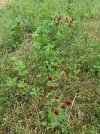
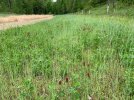
I am in the Upper Peninsula of Michigan - Latitude 45N - Zone 4b and the Crimson Clover over-wintered just fine. I couldn't even find the seed around here so I ordered it from Welters.
Here is what I planted for my 2020 brassica plots:
Land Pride 606NT No-Till Drill
Brassicas 2020 - Drilled July 9th
Large Box:
GH Forage Radish 6#/acre
Small Box:
Purple Top Turnips 1#/acre
Barkant Turnips 1#acre
Appin Forage Turnips 1#/acre
Kestrel Kale 2#/acre
Crimson Clover 2#/acre
Medium Red Clover 2#/acre
Total 9#/acre + Radish = 15#/acre
Large Box Settings for GH Radish:
Drive 2 (Calibrate using Drive 1 next time)
Seed Cup 1 (closed)
Seed Rate - 1 = 6#/acre
Small Box Setting - 43 = 9#/acre
About a month after drilling the brassica/clover mix I broadcasted rye over top of the brassica plants.
The clovers and rye did nothing to detract from the brassicas. The brassicas canopied and the deer devoured them as per usual. The difference is that when I planted stand-alone brassicas before in previous years, there was nothing but bare dirt in those plots in the spring. Here is what my brassica plots looked like this spring when clovers and rye were included in the brassica planting:
Lots of great deer forage...
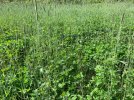
My soil is covered with a diversity of living roots creating healthy soil conditions...
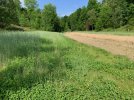
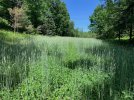
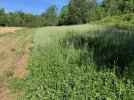
Did I mention that the deer have been enjoying those clovers all spring and summer?
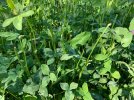
This is what last year's brassica plots looked like last week when I drilled my fall cover crop into them...

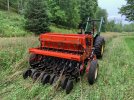
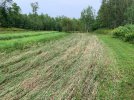
Guess what? I included 2# each of Crimson and Medium Red Clovers in my brassica plantings this year as well.
Last edited:
Wild Thing
5 year old buck +
Wild Thing
5 year old buck +
If it were me, I would not bother adding clovers to the brassica plot. There is no measureable advantage in nitrogen gain in the brassica growing season, and if you want them to take hold, you’ll have to reduce the brassica amount and lowering your yield. Depends on deer pressure on the field of course, if the “yield” matters or not..
Reducing the brassica rate to 2 lbs/ac and mixing is a great idea. If browse pressure on brassica is an issue, you've got bigger problems...
I did not find it necessary to reduce the brassica rate as the clovers were a non-issue during the brassica growing season. If you looked at my brassica plots last year you would never have known that there were any clovers included with them. It wasn't until this spring that the clovers came on strong.
These are the same brassica plots pictured above with the clovers in them. This is what they looked like last August. If they are a bit crowded it wasn't because of the clovers I planted with them. Can you see any clovers in these plots?
These photos were taken the day I broadcasted the rye into the brassicas - late August.

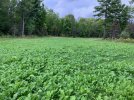

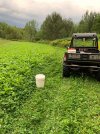
Last edited:


